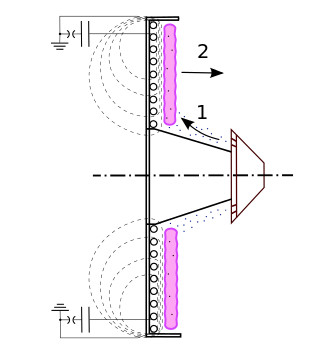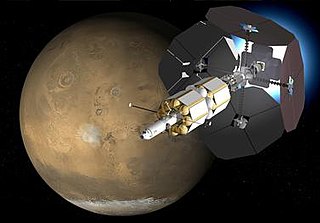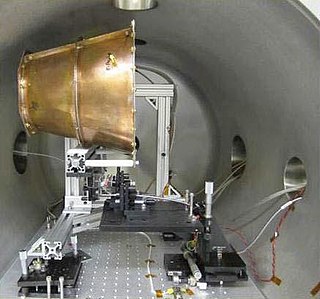Related Research Articles

Interstellar travel is the hypothetical travel of spacecraft from one star system, solitary star, or planetary system to another. Interstellar travel is expected to prove much more difficult than interplanetary spaceflight due to the vast difference in the scale of the involved distances. Whereas the distance between any two planets in the Solar System is less than 55 astronomical units (AU), stars are typically separated by hundreds of thousands of AU, causing these distances to typically be expressed instead in light-years. Because of the vastness of these distances, non-generational interstellar travel based on known physics would need to occur at a high percentage of the speed of light; even so, travel times would be long, at least decades and perhaps millennia or longer.

Spacecraft propulsion is any method used to accelerate spacecraft and artificial satellites. In-space propulsion exclusively deals with propulsion systems used in the vacuum of space and should not be confused with space launch or atmospheric entry.

In spacecraft propulsion, a Hall-effect thruster (HET) is a type of ion thruster in which the propellant is accelerated by an electric field. Hall-effect thrusters are sometimes referred to as Hall thrusters or Hall-current thrusters. Hall-effect thrusters use a magnetic field to limit the electrons' axial motion and then use them to ionize propellant, efficiently accelerate the ions to produce thrust, and neutralize the ions in the plume. The Hall-effect thruster is classed as a moderate specific impulse space propulsion technology and has benefited from considerable theoretical and experimental research since the 1960s.

An ion thruster, ion drive, or ion engine is a form of electric propulsion used for spacecraft propulsion. It creates thrust by accelerating ions using electricity.

A nuclear thermal rocket (NTR) is a type of thermal rocket where the heat from a nuclear reaction, often nuclear fission, replaces the chemical energy of the propellants in a chemical rocket. In an NTR, a working fluid, usually liquid hydrogen, is heated to a high temperature in a nuclear reactor and then expands through a rocket nozzle to create thrust. The external nuclear heat source theoretically allows a higher effective exhaust velocity and is expected to double or triple payload capacity compared to chemical propellants that store energy internally.
Beam-powered propulsion, also known as directed energy propulsion, is a class of aircraft or spacecraft propulsion that uses energy beamed to the spacecraft from a remote power plant to provide energy. The beam is typically either a microwave or a laser beam and it is either pulsed or continuous. A continuous beam lends itself to thermal rockets, photonic thrusters and light sails, whereas a pulsed beam lends itself to ablative thrusters and pulse detonation engines.

A pulsed inductive thruster (PIT) is a form of ion thruster, used in spacecraft propulsion. It is a plasma propulsion engine using perpendicular electric and magnetic fields to accelerate a propellant with no electrode.

The Variable Specific Impulse Magnetoplasma Rocket (VASIMR) is an electrothermal thruster under development for possible use in spacecraft propulsion. It uses radio waves to ionize and heat an inert propellant, forming a plasma, then a magnetic field to confine and accelerate the expanding plasma, generating thrust. It is a plasma propulsion engine, one of several types of spacecraft electric propulsion systems.

A magnetohydrodynamic drive or MHD accelerator is a method for propelling vehicles using only electric and magnetic fields with no moving parts, accelerating an electrically conductive propellant with magnetohydrodynamics. The fluid is directed to the rear and as a reaction, the vehicle accelerates forward.

Laser propulsion is a form of beam-powered propulsion where the energy source is a remote laser system and separate from the reaction mass. This form of propulsion differs from a conventional chemical rocket where both energy and reaction mass come from the solid or liquid propellants carried on board the vehicle.
An ion-propelled aircraft or ionocraft is an aircraft that uses electrohydrodynamics (EHD) to provide lift or thrust in the air without requiring combustion or moving parts. Current designs do not produce sufficient thrust for manned flight or useful loads.
A reactionless drive is a hypothetical device producing motion without the exhaust of a propellant. A propellantless drive is not necessarily reactionless when it constitutes an open system interacting with external fields; but a reactionless drive is a particular case of a propellantless drive that is a closed system, presumably in contradiction with the law of conservation of momentum. Reactionless drives are often considered similar to a perpetual motion machine. The name comes from Newton's third law, often expressed as: "For every action, there is an equal and opposite reaction."

Spacecraft electric propulsion is a type of spacecraft propulsion technique that uses electrostatic or electromagnetic fields to accelerate mass to high speed and thus generate thrust to modify the velocity of a spacecraft in orbit. The propulsion system is controlled by power electronics.

The EmDrive is a concept for a thruster for spacecraft, first written about in 2001. It is purported to generate thrust by reflecting microwaves inside the device, in a way that would violate the law of conservation of momentum and other laws of physics. The concept has at times been referred to as a resonant cavity thruster.

Non-rocket spacelaunch refers to theoretical concepts for launch into space where much of the speed and altitude needed to achieve orbit is provided by a propulsion technique that is not subject to the limits of the rocket equation. Although all space launches to date have been rockets, a number of alternatives to rockets have been proposed. In some systems, such as a combination launch system, skyhook, rocket sled launch, rockoon, or air launch, a portion of the total delta-v may be provided, either directly or indirectly, by using rocket propulsion.

Harold G. "Sonny" White is a mechanical engineer, aerospace engineer, and applied physicist who is known for proposing new Alcubierre drive concepts and promoting advanced propulsion projects.

The Asteroid Redirect Mission (ARM), also known as the Asteroid Retrieval and Utilization (ARU) mission and the Asteroid Initiative, was a space mission proposed by NASA in 2013; the mission was later cancelled. The Asteroid Retrieval Robotic Mission (ARRM) spacecraft would rendezvous with a large near-Earth asteroid and use robotic arms with anchoring grippers to retrieve a 4-meter boulder from the asteroid.
William Julius D. ("Bill") Escher was an aerospace engineer involved in the early development of the United States rocket programs and long time aerospace industry visionary. He was an internationally recognized expert in the field of high-speed airbreathing propulsion and hypersonic flight. He was a long been a proponent of combined-cycle propulsion systems for space access and his visionary 'Synerjet' concept is industry recognized. He wrote over a hundred technical papers on this subject and others such as hydrogen energy and lunar exploration.

The Princeton field-reversed configuration (PFRC) is a series of experiments in plasma physics, an experimental program to evaluate a configuration for a fusion power reactor, at the Princeton Plasma Physics Laboratory (PPPL). The experiment probes the dynamics of long-pulse, collisionless, low s-parameter field-reversed configurations (FRCs) formed with odd-parity rotating magnetic fields. FRCs are the evolution of the Greek engineer's Nicholas C. Christofilos original idea of E-layers which he developed for the Astron fusion reactor. The PFRC program aims to experimentally verify the physics predictions that such configurations are globally stable and have transport levels comparable with classical magnetic diffusion. It also aims to apply this technology to the Direct Fusion Drive concept for spacecraft propulsion.

Salvatore Cezar Pais is an American aerospace engineer and inventor, currently working for the United States Space Force. He formerly worked at the Naval Air Station Patuxent River. His patent applications for the US Navy attracted attention for their potential energy-producing applications, but also doubt about their feasibility, and speculation that they may be scams, pseudoscience, or disinformation intended to mislead the United States' adversaries.
References
- ↑ Siegel, Ethan. "For The Last Time, No, A NASA Engineer Has Not Broken Physics With An Impossible Engine". Forbes. Retrieved 2020-12-05.
- ↑ Cartwright, Jon. "NASA engineer's 'helical engine' may violate the laws of physics". New Scientist. Retrieved 2020-12-05.
- ↑ Koberlein, Brian (2019-10-16). "NASA Engineer Has A Great Idea for a High-Speed Spacedrive. Too Bad it Violates the Laws of Physics". Universe Today. Retrieved 2020-12-05.
- ↑ "NASA Technical Reports Server (NTRS)" (PDF). ntrs.nasa.gov. 19 August 2019. Retrieved 2020-12-05.
- ↑ Burns, David M. (2019-08-16), "Helical Engine", AIAA Propulsion and Energy 2019 Forum, AIAA Propulsion and Energy Forum, American Institute of Aeronautics and Astronautics, doi:10.2514/6.2019-4395, ISBN 978-1-62410-590-6, S2CID 242520152 , retrieved 2021-03-01
- ↑ Leman, Jennifer (2019-10-11). "A NASA Engineer Wants to Use a Particle Accelerator to Power Rockets". Popular Mechanics. Retrieved 2021-03-02.